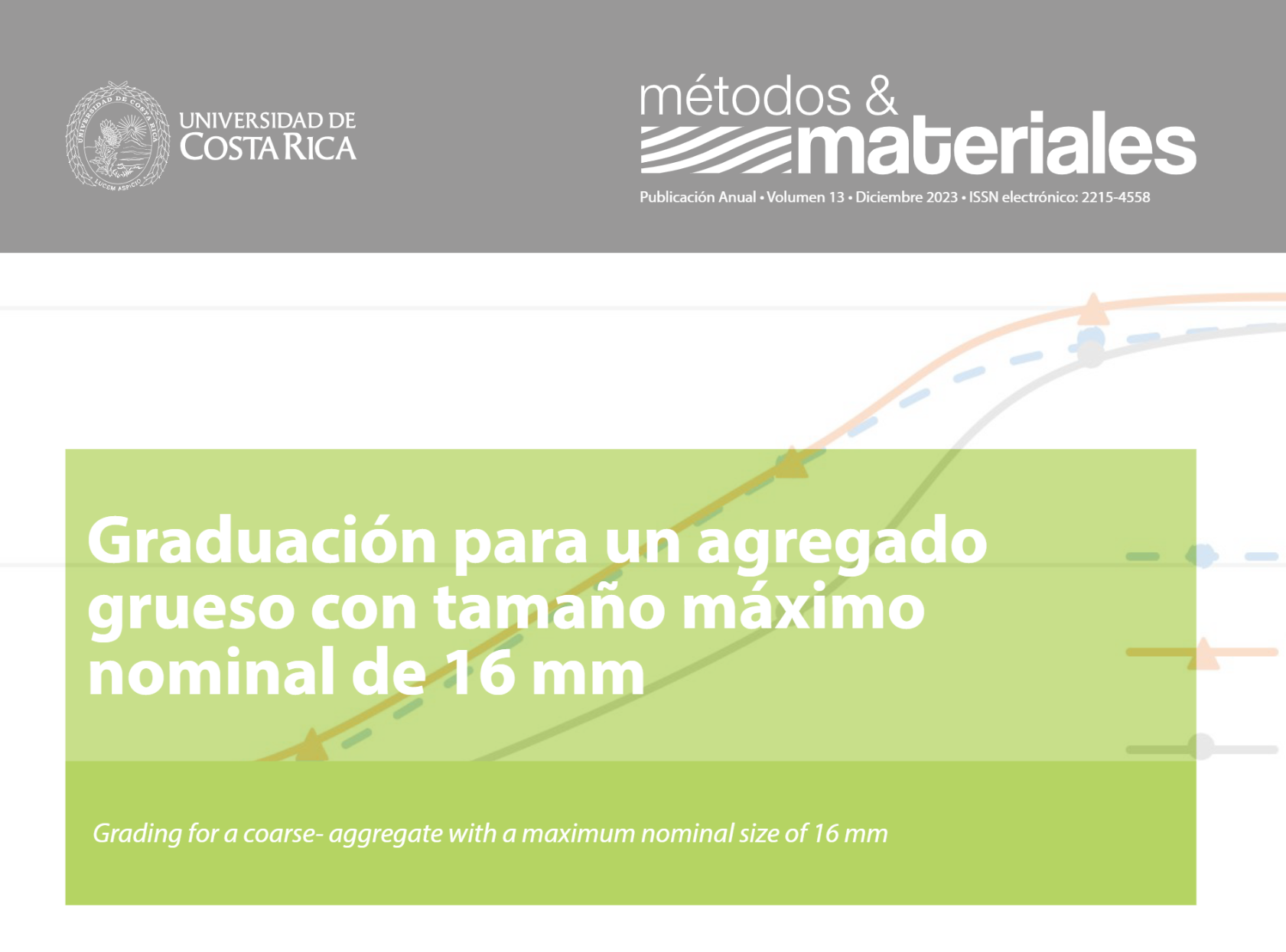Resumen
En Costa Rica, la normativa de mayor empleo en materia de especificaciones para valorar la calidad de los agregados para concreto hidráulico, corresponde a la de la Sociedad Americana de Pruebas y Materiales (ASTM, por sus siglas en inglés), las cuales constituyen la base de las normas del Instituto de Normas Técnicas de Costa Rica (INTECO).
Por ende, los requerimientos de graduación de los agregados que se sigue en el país provienen de la norma ASTM C33 Especificación normalizada para agregados para concreto (INTE C15:2014). Para el diseño de mezclas, esta norma proporciona especificaciones granulométricas para tamaños máximos nominales de 90 mm, 63 mm, 50 mm, 37,5 mm, 25 mm, 19 mm, 12,7 mm y 9,5 mm.
No obstante, en estudios recientes, Hernández (2018) y Delgado (2018), utilizaron un agregado con tamaño máximo nominal de 16 mm en la elaboración de concreto hidráulico para obtener curvas estándar de desarrollo de resistencia para diferentes tipos de cemento portland que se comercializan en el país. En sus trabajos, tanto Hernández como Delgado, utilizaron agregado grueso de río y agregado grueso de tajo. Para cada caso se usó como referencia granulométrica las especificaciones para tamaños máximos nominales de 12,7 mm y 19 mm que proporciona la norma ASTM C33 (INTE C15:2014), dado que en esta norma no existen especificaciones para agregado de 16 mm.
Fuentes productoras de agregados a nivel nacional están generando una cantidad importante de agregado de 16 mm, por lo que resultó de interés realizar un estudio experimental con muestras estadísticamente válidas, que permitan comprobar con un grado de certeza adecuado la validez de usar la granulometría que mejor se ajuste (tamaño máximo nominal: 12,7 mm o 19 mm) cuando se emplea agregado de 16 mm. Pero también, como parte del estudio, se generó una propuesta de límites granulométricos para un tamaño de 16 mm.
Citas
American Concrete Institute. (2002). ACI 211.1-91 Práctica estándar para seleccionar el proporcionamiento de concreto de peso normal, pesado y masivo.
American Society for Testing and Materials. (2014). ASTM D75-14. Práctica normativa para el muestreo de agregados.
American Society for Testing and Materials. (2015). ASTM C128-15. Método de ensayo normalizado para determinar la densidad, la densidad relativa o gravedad específica, y la absorción de agregados finos.
American Society for Testing and Materials. (2015). ASTM C143/ C143M-15. Método de prueba estándar para determinar el asentamiento de concreto de cemento hidráulico.
American Society for Testing and Materials. (2016). ASTM C109-16. Método de prueba estándar para la resistencia a la compresión de morteros de cemento hidráulico.
American Society for Testing and Materials. (2016). ASTM C183-16. Práctica normalizada para muestreo y cantidad de pruebas de cemento hidráulico.
American Society for Testing and Materials. (2016). ASTM C192- 16. Práctica normalizada para preparación y curado de
especímenes de concreto para ensayo en laboratorio.
American Society for Testing and Materials. (2017). ASTM C1064- 17/C1064M-17. Método de prueba estándar para determinar la temperatura del concreto fresco de cemento hidráulico.
American Society for Testing and Materials. (2017). ASTM C138-17/ C138M-17a. Método de prueba estándar para determinar la densidad (peso unitario) y rendimiento del concreto fresco.
American Society for Testing and Materials. (2017). ASTM C231-17/ C231M-17a. Método de prueba estándar para determinar el contenido de aire de concretro fresco con el método de presión.
American Society for Testing and Materials. (2017). ASTM C29/C29- 17a. Método de prueba estándar para determinar la densidad masiva (“Peso unitario”) y vacíos en agregados.
American Society for Testing and Materials. (2018). ASTM C33- 18/C33M-18. Especificaciones estándar para agregados para concreto.
American Society for Testing and Materials. (2018). ASTM C702/ C702M-18. Práctica estándar para reducir muestras de agregados a tamaño de ensayo.
American Society for Testing and Materials. (2018). ASTM C78- 18/C78M-18. Método de prueba estándar para determinar la resistencia a flexión del concreto American Society for Testing and Materials. (2019).
ASTM C136/ C136M-19. Método de prueba estandar para el análisis por mallas para el agregado fino y grueso.
American Society for Testing and Materials. (2020). ASTM C39-20/C39M-20. Método de prueba estándar para determinar la resistencia a compresión de especímenes cilíndricos de concreto.
American Society for Testing and Materials. (2020). ASTM C40/C40M-19. Método de prueba estándar para determinar impurezas orgánicas en agregado fino para concreto. ASTM Internacional.
Delgado, J. A. (2018). Curvas características de resistencia a compresión simple en concreto usando distintos tipos de cementos modificados. Proyecto final de graduación para optar por el título de Licenciatura en Ingeniería Civil, Escuela de Ingeniería Civil, Universidad de Costa Rica, San José, Costa Rica.
Hernández, L. F. (2018). Resistencia a la compresión simple versus tiempo de curado en especímenes de concreto hidráulico usando
cementos modificados. Proyecto final de graduación para optar por el título de Licenciatura en Ingeniería Civil, Escuela de ingeniería Civil, Universidad de Costa Rica , San José
##plugins.facebook.comentarios##

Esta obra está bajo una licencia internacional Creative Commons Atribución-NoComercial-SinDerivadas 4.0.
Derechos de autor 2023 Métodos y Materiales






